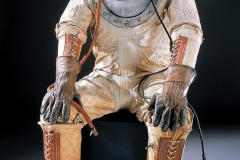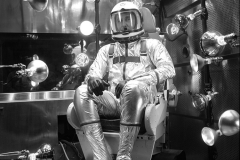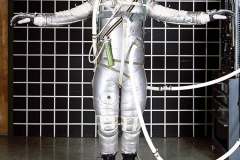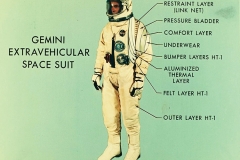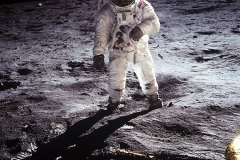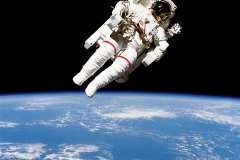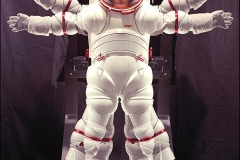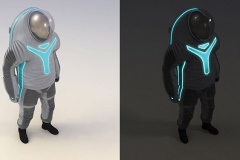One hundred years of problem solving started with one crazy idea. What came after was even crazier. Looking back on the spacesuit’s evolution to make sense of what’s coming next.
“The spacesuit is a spacecraft. It does everything a spacecraft does, except reenter.”
—Amy Ross (ME’94, MS ME’96)
Few work uniforms have achieved iconic status like the spacesuit. Protecting Earth’s most ardent explorers, the suit symbolizes mankind’s propensity for discovery as well as the risks inherent in such bold endeavors. Without the suit, a human would die in space within minutes.
When Neil Armstrong (AAE’55, HDR E’70) set foot on the lunar surface in 1969, he was wearing a space suit developed by ILC Dover, based in Delaware. The company has been active in the development of spacesuits and equipment since 1952, when its metals division was awarded a contract to supply the Navy and Air Force with high-altitude pressure helmets. This helmet technology was the genesis for full-body high-altitude pressure suits like the Navy Mark IV, developed by BF Goodrich and worn by the Mercury Seven, Virgil “Gus” Grissom (ME’50) among them. The most severe test of the Mark IV suit took place on a 1961 balloon flight led by Malcolm Ross (S’41).
The latest suit in development at ILC Dover, the Z-2 Spacesuit, represents the first complete redesign in almost three decades. Amy Ross (ME’94, MS ME’96) is heading up the project as lead of NASA’s advanced pressure
garment development.
“The pressure garment is the human-shaped part of the suit that retains air and pressure and has joints for mobility. Attached to the back of the pressure garment is the box that holds the life support system,” Ross says.
“We will receive the new pressure garment this fall. It could be used for a mission to the Moon or Mars. The Z-2 is much more mature than anything we’ve done before. We’ll test it and use the data to improve the next iteration.”
Whether the next mission returns astronauts to the Moon or realizes the dream of a manned mission to Mars, the Z-2 represents the latest advances in safety. Part fashion statement, part personal spaceship and life support pod, the suit has undergone many transformations over the years, but the goal of solid suit design has remained constant — creating a protective environment that enables astronauts to work in the harsh environment of outer space and deliver them safely home.


